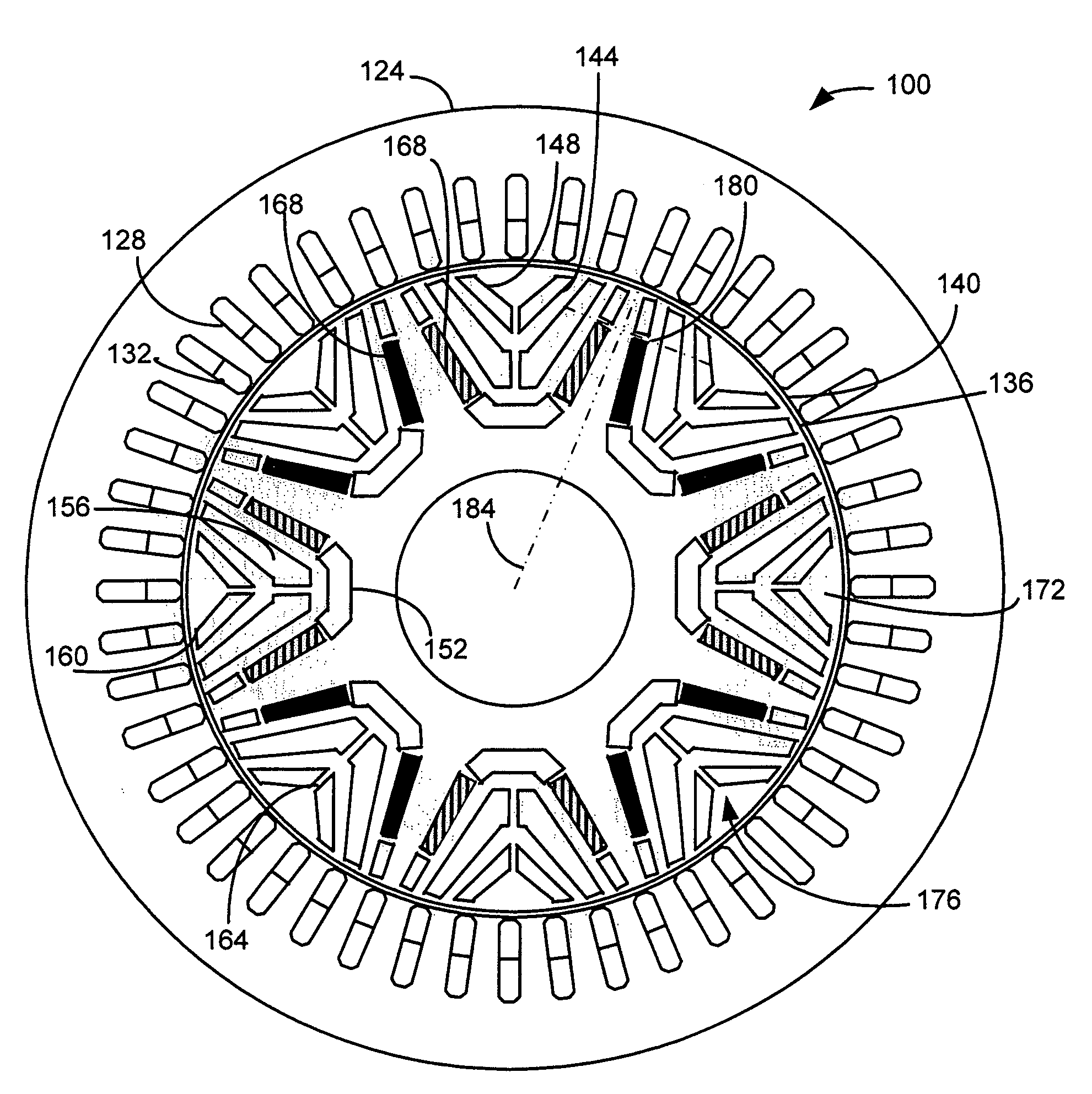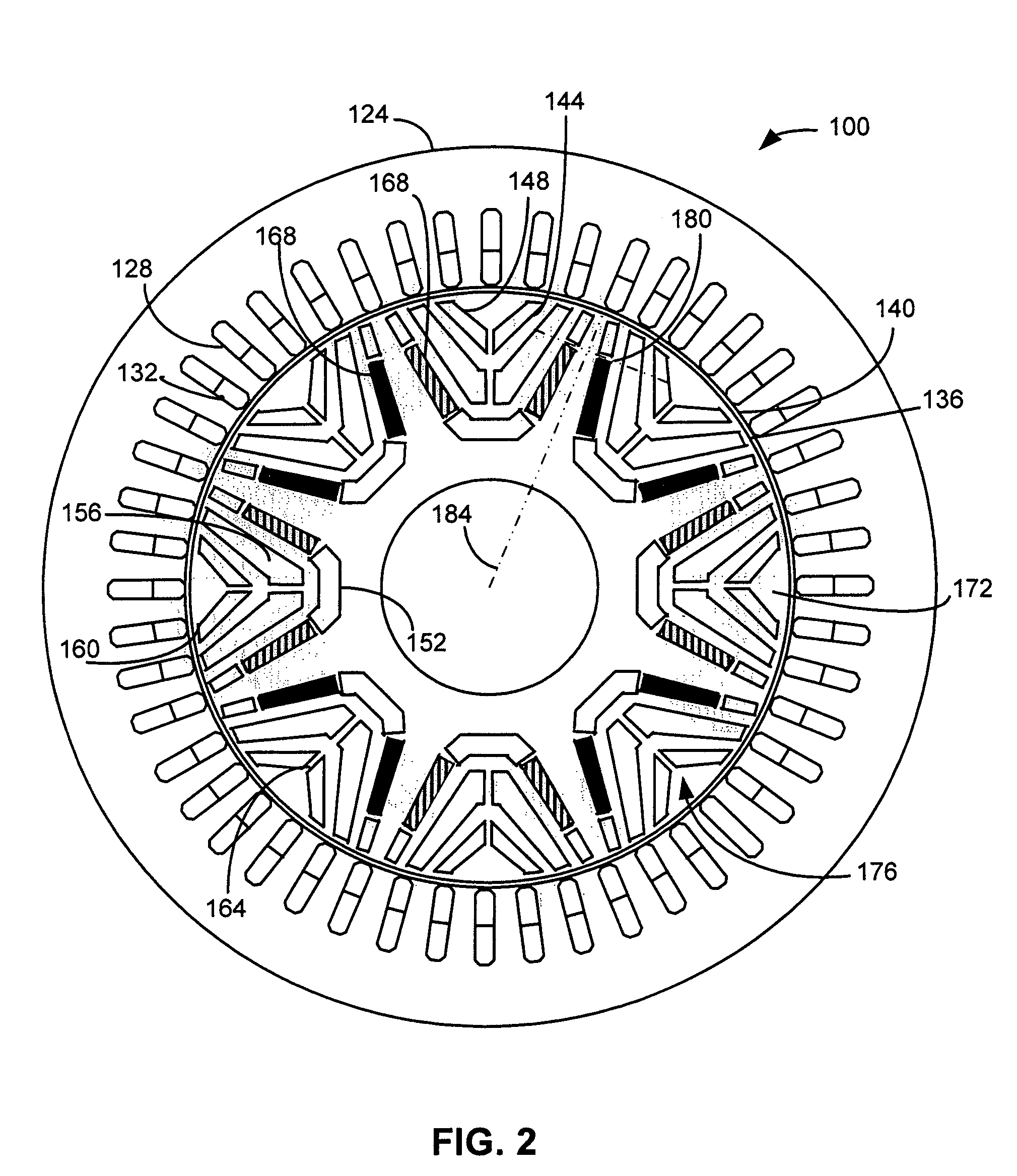Rotor magnet placement in interior permanent magnet machines
a permanent magnet machine and magnet technology, applied in the direction of dynamo-electric machines, magnetic circuit rotating parts, magnetic circuit shape/form/construction, etc., can solve the problems of rotor loss and magnet heating, complicated rotor manufacturing, and magnets that are vulnerable to demagnetization, so as to reduce the variation of rotor flux
- Summary
- Abstract
- Description
- Claims
- Application Information
AI Technical Summary
Benefits of technology
Problems solved by technology
Method used
Image
Examples
first embodiment
[0017]A cross-sectional view of a multi-barrier synchronous IPM machine is indicated generally in FIG. 1 by reference number 20. The machine 20 includes a stator 24 having a plurality of slots 28 through which multiphase windings 32 are wound. In the embodiment shown in FIG. 1, the stator 24 has forty-eight slots 28. A rotor 36 is separated from the stator 24 by an air gap 40. A plurality of slots 44 in the rotor 36 form a plurality of barriers 48, for example, inner barriers 52, middle barriers 56 and outer barriers 60. The slots 44 in a barrier 48 may be separated by bridges 64.
[0018]A plurality of sintered permanent magnets 68 are located in slots 44 of the inner barriers 52 near an outer surface 72 of the rotor 36. The rotor 36 includes a plurality of magnetic poles, one of which is indicated generally by reference number 76. Each pole 76 is formed at least in part by the magnets 68 in the slots 44. In the embodiment shown in FIG. 1, the rotor 36 has eight poles 76.
[0019]The afo...
second embodiment
[0021]A cross-sectional view of a multi-barrier IPM machine is indicated generally in FIG. 2 by reference number 100. The machine 100 includes a stator 124 having a plurality of slots 128 through which multiphase windings 132 are wound. In the embodiment shown in FIG. 2, the stator 124 has forty-eight slots 128. A rotor 136 is separated from the stator 124 by an air gap 140. A plurality of slots 144 in the rotor 136 form a plurality of barriers 148, for example, inner barriers 152, middle barriers 156 and outer barriers 160. The slots 144 in each barrier 148 may be separated by bridges 164.
[0022]A plurality of sintered permanent magnets 168 are located in slots 144 of the inner barriers 152. The rotor 136 includes a plurality of magnetic poles, one of which is indicated generally by reference number 172. Each pole 172 is formed at least in part by the magnets 168 in the slots 144. In the embodiment shown in FIG. 2, the rotor 136 has eight poles 172.
[0023]The magnets 168 are recesse...
PUM
 Login to View More
Login to View More Abstract
Description
Claims
Application Information
 Login to View More
Login to View More - R&D
- Intellectual Property
- Life Sciences
- Materials
- Tech Scout
- Unparalleled Data Quality
- Higher Quality Content
- 60% Fewer Hallucinations
Browse by: Latest US Patents, China's latest patents, Technical Efficacy Thesaurus, Application Domain, Technology Topic, Popular Technical Reports.
© 2025 PatSnap. All rights reserved.Legal|Privacy policy|Modern Slavery Act Transparency Statement|Sitemap|About US| Contact US: help@patsnap.com



